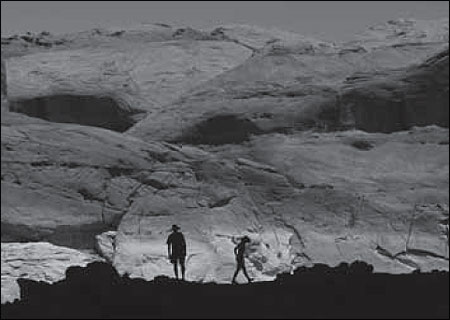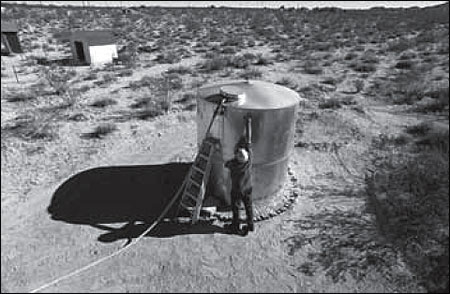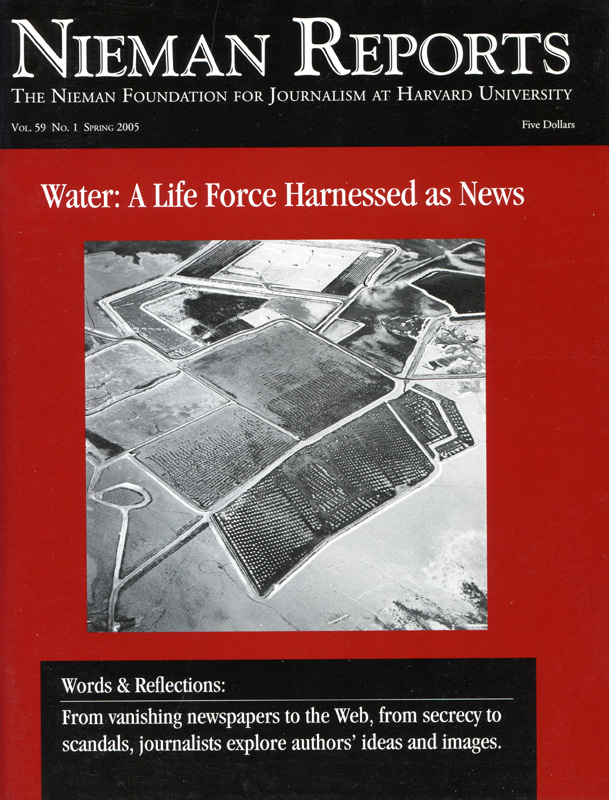
When I tell colleagues that I cover water issues in the West, I often get looks of pity. It is as if I’m drowning in a sea of minutia. But to my way of thinking, they are the ones missing out on the joys and challenges of this remarkable beat.
I write about water for The Associated Press from San Diego. What makes it interesting is that there isn’t enough water to go around. To give an idea how bad things are, the record-breaking rainfall that sent Southern California homes skidding off their foundations this winter wasn’t enough to solve the West’s ongoing water problems. It will take a few years before we can write “The Drought Is Over” story. After five By Its Absence Water Becomes a Big Story ‘I try to focus my coverage on people whose lives intersect with water.’ dry years, the fat lady hasn’t sung yet.
In the dry West, water is everything: It’s power, and it’s the engine of growth. With it, a community like Phoenix can build more homes, attract business, fill swimming pools, and create jobs even in the triple-digit summer heat. Giving up a precious resource like water is tantamount to committing communal suicide. I’ve visited places, such as Colorado’s Arkansas Valley in the Front Range prairie east of Denver, which have sold water to other places. They are sad places, and the only industries they seem able to attract are prisons.
Huge federal works projects—the Hoover Dam and Glen Canyon Dam, to name a few of the biggest—have been constructed to pool and distribute what little water exists. During the past few decades, the Colorado River, America’s Nile, has been transformed into a massive plumbing system ferrying precious Rocky Mountain water to the deserts of the American Southwest. Aqueducts carry water across the desert, for example, to the millions who live in and near San Diego.
The West’s Water Crisis
Last year, Bennett Raley, a Colorado cowboy-turned-lawyer who was the Bush administration’s top Western water official, led me and four other journalists from The New York Times, Los Angeles Times, The Sacramento Bee, and The San Diego Union-Tribune down the Colorado River through the Grand Canyon for a week-long floating seminar on endangered species, drought and a behind-the-scenes look at water politics.
Now, Raley assured us, the region is facing a water crisis unlike any in its history. Five of the driest years on record have dried out the American West. From the brittle canyons of Southern California to the sun-blasted fields of Idaho, the nation’s fastest-growing region is being choked by drought. At the same time, demand is pushing the region’s water supplies past their limits. Water supplies are dwindling and drought-stricken forests are raked by huge wildfires. The “Cadillac Desert” that the late author Marc Reisner described in his book is being sucked dry.
The stakes are huge. Drought is already doing what environmentalists could only dream of: It’s draining Lake Powell. The lake, one of two major storage reservoirs on the Colorado River, is less than half full and sinking. A recent issue of Backpacker magazine featured a hiking guide to Powell’s canyons that were until recently submerged underwater. The lake is a few years away from being so low that no water could be released from the dam into the Grand Canyon. The dam’s cheap hydropower would be lost, which could raise electricity prices and play havoc with the Western power market.
Las Vegas, which gets almost all its water from Lake Mead and the Colorado River, is already in big trouble. The city has been paying millions of dollars to homeowners who were willing to rip out their front lawns. Vegas is on the verge of a self-imposed drought emergency as Lake Mead continues to fall lower and lower. Something the city’s water wonks are loath to discuss is the thought of drought silencing the ice cubes clinking in casino highball glasses.

Reporting on Water
Perhaps because few reporters take much of an interest in water, I’m given wide latitude to cover it. My stories range across the West, but I have a rule I try to follow in all of them: Keep numbers to a minimum. Environmental stories can so easily get bogged down in parts per million or acre-feet of water. These are measurements that are irrelevant to the lives of most readers. Only farmers understand what an acre-foot of water means. (It’s a lot of water given that it takes two years for a typical family of four to use just a single acre-foot.)
I try to focus my coverage on people whose lives intersect with water. Rural Imperial County, California’s poorest, is often forgotten, but it’s full of colorful people. What draws journalists to this dry corner of California is the region’s water. The agricultural region grows a sizeable chunk of the nation’s wintertime vegetables and uses incredible amounts of Colorado River water to do it. Los Angeles, San Diego, and others have long coveted buying up Imperial’s water for urban use, but Imperial has been stubborn about letting go. A 95-year-old farmer sat with me one day under a mammoth Indian pepper tree and told me about the days when the field across the street was a sand dune. As long as he was around, the cities wouldn’t get the water he had to work so hard for. Also in Imperial, I met Stella Mendoza, the daughter of a cantaloupe picker who described her childhood as straight out of “The Grapes of Wrath.” She, too, refused to part with the valley’s water. “Without water,” she said, “we are nothing.”
The story of water in the West has a natural tension that makes it easy to write. Farmers and cities, rival water districts, and even some states seem locked in permanent feuds that have almost become a way of life out here. Historian Norris Hundley, Jr., author of “The Great Thirst,” encouraged me to be patient and take the long view of such conflicts. “It’s not going to be over until it’s over,” he said. “And even then it’s not over.” Taking this long-term outlook is not easy for any journalist, especially an A.P. reporter, but I’ve come to understand, as I’ve covered this beat, just how good his guidance is.
A major water war broke out in 2002 when California backed away from a long-awaited pact and angered the six other states that share the Colorado River. California had promised to stop overusing the river’s water, but a rural water board backed away at the last minute, and the deal collapsed. The state and federal government kept pressure on all sides to bring them back to the table.
Some old-fashioned sourcing allowed me to break another big story in 2003: In a scene straight out of “Chinatown,” former Governor Gray Davis threatened to allow water destined for Southern California to flow into the ocean to keep the parties in line. A source in a Southern California water agency let me know what was going on in the hope of getting the governor to back off. Davis, who was soon to be recalled by voters, refused to do so and, through a spokesman, made clear that he was withholding water as a political bargaining chip. My story about this became an instant embarrassment to Davis, since the federal Department of the Interior did not like the idea of anyone flushing water into the ocean in the midst of a drought. Davis had to apologize and backtrack on his threat.
See "The Owens Lake Project" for photos of Owens Lake »There’s also a compelling history to water. The water grab that Jack Nicholson uncovers in the 1974 film “Chinatown” isn’t entirely fiction. The farming community of the Owens Valley, in the high desert of the eastern Sierra, became a dust bowl when Los Angeles quietly acquired its water and flushed it down an aqueduct 90 years ago. “Whoever brings the water, brings the people,” wrote William Mulholland, the aqueduct’s legendary creator.
Modern-day water speculators still stalk the waterways of the West. Denver investors bought up a sugar-beet refinery and sold the water associated with it to the suburb of Aurora 20 years ago. A decade later, brothers Lee and Edward Bass, Texas oil barons, quietly bought up land in California’s Imperial Valley and then unsuccessfully tried to sell the water out from under it. Ever-growing Los Angeles is still on the hunt for more water as well, but it doesn’t just grab it anymore. It created a $1 billion-a-year quasi-government entity that conducts its affairs like any other modern government institution. It hires lobbyists and spin masters, pays consultants to spy on its enemies, and spends millions of dollars of taxpayer money in questionable ways.
There’s rich fodder for journalists in these huge urban water agencies. In California, these “special districts,” which can tax residents and spend their money, exist by the thousands with little built-in public oversight. Since they are public entities, they do have to open their records to public inspection, and when one record search was done what turned up were expenses for lavish dinners and country club parties with little, if any, purpose. The Los Angeles Times’s reporting on excessive billing of the Los Angeles Department of Water and Power by Fleishman-Hillard, a public relation’s firm, led to the criminal indictment of one of that firm’s executives.
Finally, the unreal way water is used in the West makes for compelling stories—the same notion that makes Reisner’s “Cadillac Desert” so interesting. Consider Palm Springs. At nearby Palm Desert’s Desert Springs Marriott, guests ride gondolas to feast on ahi steaks by the edge of a sprawling lake. There’s a man-made water-ski lake. A new shopping mall was built around a man-made river. In ultra-wealthy Indian Wells, thirsty lawns aren’t even a choice; they’re required. Desert sands have been transformed into the self-ordained “golf capital of the world” by cheap and abundant water. This water comes from the Colorado River through deals negotiated decades ago, when water was cheap and seen as abundant and, if renegotiations were attempted, they’d be entangled in lawsuits for decades ahead.
All of this is taking place in an area described by 19th century explorer John Wesley Powell as “the most desolate region on the continent.” Rainfall averages just three inches a year, but per-family water usage is nearly three times the U.S. average. This is because many places—such as Las Vegas and Palm Springs—have built their tourist economies around water. Though water experts and some journalists are trying to dispel the myth of the West’s abundant water, few are heeding the warning that the emperor has no clothes.
Seth Hettena reports on water for The Associated Press in San Diego.



